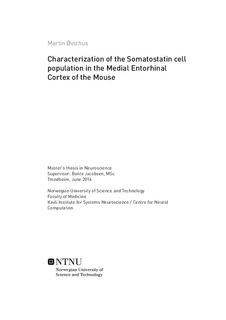| dc.description.abstract | The medial entorhinal cortex receives converging input from the hippocampal formation, the parahippocampal region and multiple neocortical and subcortical regions. Since the discovery of spatially modulated cells, the medial entorhinal cortex is suggested to have a strong functional role in spatial navigation. In the process to illuminate the mysteries of the underlying spatial circuitry, a lot of attention has been directed toward the cell populations residing in the medial entorhinal cortex. Interneurons are indicated to have an important role in modulation of the local principal cells in cortical networks. However, in the medial entorhinal cortex, little is known about the different interneuron population.
The aim of this thesis was to describe the distribution and monosynaptic inputs to the somatostatin cell population of the medial entorhinal cortex, as well as optimizing the viral tracing protocol. To characterize the distribution of somatostatin cells, an adeno-associated virus helper virus was injected into the medial entorhinal cortex of somatostatin-Cre mice. To visualize monosynaptic tracing, somatostatin-Cre mice were injected with adeno-associated virus helper virus, followed by an incubation period and injection of EnvA G-deleted rabies virus. The brains were cut in the horizontal plane and cortical areas were delineated based on Nissl stains with Cresyl Violet. Adeno-associated virus helper virus and rabies virus fluorescent expression were immunohistochemically enhanced with AlexaFluor® dyes, and the viral expression was analyzed with confocal microscopy.
I tested multiple viral tracing protocols and the results showed that in order to receive optimal monosynaptic transport, the monosynaptic tracing method worked better in case of moderate to large injections with high titer virus. Immunohistochemical analyzes showed that the SST cell population was confined to deep layers of the MEC, whereas local monosynaptic labelled rabies cells were confined to and projected to superficial layers. Long-distance labelled cells were observed in the hippocampal formation, the parahippocampal region, the retrosplenial cortex and the medial septum. The results indicate that the somatostatin cells mainly receive inputs to starter cells in superficial layers. Long-distant monosynaptic transport show that the medial entorhinal cortex received stronger input from the parahippocampal region and the hippocampal formation than from neocortical and subcortical structures. | nb_NO |
